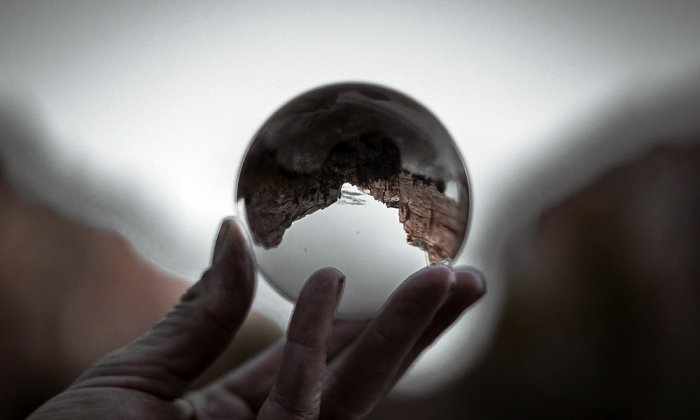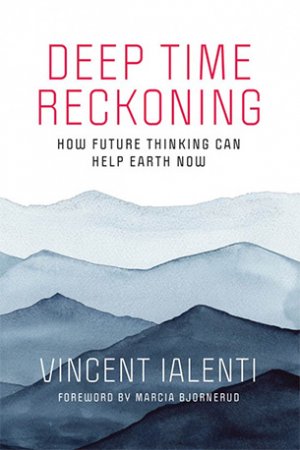The Art of Pondering Distant Future Earths

The word has been out for decades: We were born on a damaged planet careening toward environmental collapse. Yet our intellects are poorly equipped to grasp the scale of the Earth’s ecological death spiral. We strain to picture how, in just a few decades, climate change may displace entire populations. We struggle to envision the fate of plastic waste that will outlast us by centuries. We fail to imagine our descendants inhabiting an exhausted Earth worn out from resource extraction and devoid of biodiversity. We lack frames of reference in our everyday lives for thinking about nuclear waste’s multimillennial timescales of radioactive hazard.
I am an anthropologist who studies how societies hash out relationships between living communities of the present and unborn communities imagined to inhabit the future. Studying how a community relates to the passage of time, I’ve learned, can offer a window into its values, worldviews, and lifeways.

From 2012 to 2014, I conducted 32 months of anthropological fieldwork exploring how Finland’s nuclear energy waste experts grappled with Earth’s radically long-term future. These experts routinely dealt with long-lived radionuclides such as uranium-235, which has a half-life of over 700 million years. They worked with the nuclear waste management company Posiva to help build a final disposal facility approximately 450 meters below the islet of Olkiluoto in the Gulf of Bothnia in the Baltic Sea. If all goes according to plan, this facility will, in the mid-2020s, become the world’s first operating deep geologic repository for spent nuclear fuel.
To assess the Olkiluoto repository’s long-term durability, these experts developed a “safety case” forecasting geological, hydrological, and ecological events that could potentially occur in Western Finland over the coming tens of thousands — or even hundreds of thousands — of years. From their efforts emerged visions of distant future glaciations, climate changes, earthquakes, floods, human and animal population changes, and more. These forecasts became the starting point for a series of “mental time travel” exercises that I incorporated into my book, “Deep Time Reckoning.”
Stretching the mind across time — even in the most speculative ways — can help us become more responsible planetary stewards: It can help endow us with the time literacy necessary for tackling long-term challenges such as biodiversity loss, microplastics accumulation, climate change, antibiotic resistance, asteroid impacts, sustainable urban planning, and more. This can not only make us feel more at home in pondering our planet’s pasts and futures. It can also draw us to imagine the world from the perspective of future human and non-human communities — fostering empathy across generations.
5710 CE. A tired man lounges on a sofa. He lives in a small wooden house in a region once called Eurajoki, Finland. He works at a local medical center. Today is his day off. He’s had a long day in the forest. He hunted moose and deer and picked lingonberries, mushrooms, and bilberries. He now sips water, drawn from a village well, from a wooden cup. His husband brings him a dinner plate. On it are fried potatoes, cereal, boiled peas, and beef. All the food came from local farms. The cattle were watered at a nearby river. The crops were watered by irrigation channels flowing from three local lakes.
The man has no idea that, more than 3,700 years ago, safety case biosphere modelers used 21st-century computer technologies to reckon everyday situations like his. He does not know that they once named the lakes around him — which formed long after their own deaths — “Liiklanjärvi,” “Tankarienjärvi,” and “Mäntykarinjärvi.” He is unaware of Posiva’s ancient determination that technological innovation and cultural habits are nearly impossible to predict even decades in advance. He is unaware that Posiva, in response, instructed its modelers to pragmatically assume that Western Finland’s populations’ lifestyles, demographic patterns, and nutritional needs will not change much over the next 10,000 years. He does not know the safety case experts inserted, into their models’ own parameters, the assumption that he and his neighbors would eat only local food.
Yet the hunter’s life is still entangled with the safety case experts’ work. If they had been successful, then the vegetables, meat, fruit, and water before him should have just a tiny chance of containing only tiny traces of radionuclides from 20th-century nuclear power plants.
12020 CE. A solitary farmer looks out over her pasture, surrounded by a green forest of heath trees. She lives in a sparse land once called Finland, on a fertile island plot once called Olkiluoto. The area is an island no longer. What was once a coastal bay is now dotted with small lakes, peat bogs, and mires with white sphagnum mosses and grassy sedge plants. The Eurajoki and Lapijoki Rivers drain out into the sea. When the farmer goes fishing at the lake nearby, she catches pike. She watches a beaver swim about. Sometimes she feels somber. She recalls the freshwater ringed seals that once shared her country before their extinction.
The woman has no idea that, deep beneath her feet, lies an ancestral deposit of copper, iron, clay, and radioactive debris. This is a highly classified secret — leaked to the public several times over the millennia, but now forgotten. Yet even the government’s knowledge of the burial site is poor. Most records were destroyed in a global war in the year 3112. It was then that ancient forecasts of the site, found in the 2012 safety case report “Complementary Considerations,” were lost to history.
But the farmer does know the mythical stories of Lohikäärme: a dangerous, flying, salmon-colored venomous snake that kills anyone who dares dig too close to his underground cave. She and the other farmers in the area grow crops of peas, sugar beet, and wheat. They balk at the superstitious fools who tell them the monster living beneath their feet is real.
35,012 CE. A tiny microbe floats in a large, northern lake. It does not know that the clay, silt, and mud floor below it is gaining elevation, little by little, year after year. It is unaware that, 30 millennia ago, the lake was a vast sea. Dotted with sailboats, cruise and cargo ships, it was known by humans as the Baltic. Watery straits, which connected the Baltic Sea to the North Sea, had risen above the water thousands of years ago. Denmark and Sweden fused into a single landmass. The seafloor was decompressing from the Weichselian glaciation — an enormous sheet of ice that pressed down on the land during a previous ice age.
After the last human died, the landmass kept on rising. Its uplift was indifferent to human extinction. It was indifferent to how, in 2013 CE, an anthropologist and a safety case expert sat chatting in white chairs in Ravintola Rytmi: a café in Helsinki. There, the safety case expert relayed his projection that, by 52,000 CE, there would no longer be water separating Turku, Finland, and Stockholm, Sweden. At that point, one could walk from one city to the other on foot. The expert reckoned that, to the north — between Vaasa, Finland, and Umeå, Sweden — one would someday find a waterfall with the planet’s largest deluge of flowing water. The waterfall could be found at the site of a once-submerged sea shelf.
The microbe, though, does not know or care about Vaasa, Umeå, Denmark, long-lost boats, safety case reports, or Helsinki’s past dining options. It has no concept of them. Their significances died with the humans. Nor does the microbe grasp the suffering they faced when succumbing to Anthropocene collapse. Humans’ past technological feats, grand civilizations, passion projects, intellectual triumphs, wartime sacrifices, and personal struggles are now moot. And yet, the radiological safety of the microbe’s lake’s waters still hinges on the work of a handful of human safety case experts who lived millennia ago. Thinking so far ahead, these experts never lived to see whether their deep time forecasts were accurate.
We do not, of course, live in these imagined worlds. In this sense, they are unreal — merely fictions. However, our capacities to envision potential futures, and to feel empathy for those who may inhabit them, are very real. Depictions of tomorrow can have powerful, concrete effects on the world today. This is why deep time thought experiments are not playful games, but serious acts of intellectual problem-solving. It is why the safety case experts’ models of far future nuclear waste risks are uniquely valuable, even if they are, at the end of the day, mere approximations.
Yet pondering distant future Earths can also help us take a step back from our everyday lives — enriching our imaginations by transporting our minds to different places and times. Corporate coaches have recommended taking breaks from our familiar thinking patterns to experience the world in new ways and overcome mental blocks. Cognitive scientists have shown how creativity can be sparked by perceiving “something one has not seen before (but that was probably always there).”
Putting aside a few minutes each day for long-termist, planetary imagination can enrich us with greater mental dexterity in navigating between multiple, interacting timescales. This can cultivate more longsighted empathy for landscapes, people, and other organisms across decades, centuries, and millennia. As the global ecological crisis takes hold, embracing planetary empathy will prove essential to our collective survival.
—
Vincent Ialenti is a Research Fellow at The University of Southern California and The Berggruen Institute. His recent book, “Deep Time Reckoning,” is an anthropological study of how Finland’s nuclear waste repository experts grappled with distant future ecosystems and the limits of human knowledge.



